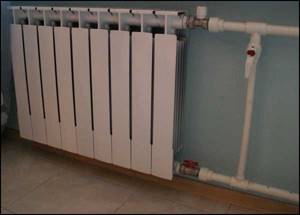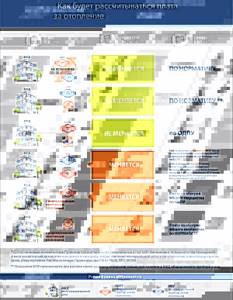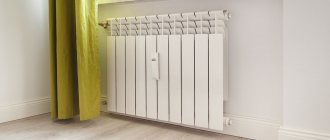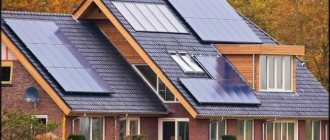Heating How Many Gcal Per Square Meter in 2021
In accordance with the “Rules for the provision of utility services to citizens,” approved by Decree of the Government of the Russian Federation No. 307 of May 23, 2006, the air temperature in residential premises should be no lower than +18 degrees Celsius, in corner rooms no lower than +20 degrees. These are the "basic parameters". But the climatic conditions in Russia are so diverse that regions have the right to change the “main standard” in one direction or another. Bathroom +25; lobby, staircase +16; elevator room +5; basement +4; attic +4. The air temperature is measured on the inner wall of each room at a distance of one meter from the outer wall and 1.5 meters from the floor. But only after the start of the heating season. There are no standards for the off-season.
In the production of utility services for heating or hot water supply, various utility resources can be used, such as electrical energy, cold water supply, gas or other fuel.
What is Gcal
We should start with a related definition. A calorie refers to the specific amount of energy required to heat one gram of water to one degree Celsius (at atmospheric pressure, of course). And due to the fact that from the point of view of heating costs, say, at home, one calorie is a tiny amount, gigacalories (or Gcal for short), corresponding to one billion calories, are used for calculations in most cases. We've decided on this, let's move on.
The use of this value is regulated by the relevant document of the Ministry of Fuel and Energy, published back in 1995.
Note! On average, the consumption standard in Russia per square meter is 0.0342 Gcal per month. Of course, this figure may vary for different regions, since everything depends on climatic conditions
So, what is a gigacalorie if we “transform” it into values that are more familiar to us? See for yourself.
1. One gigacalorie is equal to approximately 1,162.2 kilowatt-hours.
2. One gigacalorie of energy is enough to heat a thousand tons of water to +1°C.
Rules for calculating utility bills per square meter
Thus, approximately the amount of rent over the last year for a family with no more than three or four people has increased by 200 or 300 rubles. Of course, all these are average indicators, which may vary depending on the region in which the citizen lives.
- In the process of calculating heating, utility workers can use different calculation options. The first option involves paying the required amount during the heating season, and in this case the total area of the apartment and the established tariff are taken into account. If heating is paid for all year round, then in this case an approximate average consumption rate is established, and in addition, the established tariff and the area of the property are taken into account.
- Gas consumption is calculated in accordance with the meter readings. If there are no individual metering devices on the premises, then the total area of the premises, the established standards for heating and cooking, the number of residents, as well as the tariff that operates at the regional level are used as the basis.
- The amount of electricity and water consumed is carried out by multiplying the total number of people living in the apartment by the current tariffs or standards. The use of such a system is carried out if it is not possible to take readings from the installed meters in the apartment.
- Apartment drainage is calculated in accordance with a similar system. In this case, the indicators of installed metering devices are taken as meter readings, which are initially summed up and then multiplied by the existing tariff. In the absence of individual metering devices, the distribution of the standard is carried out in accordance with the number of people living in the apartment.
When you need to dot all the i’s
But a completely reasonable question arises. “How can you count something that is invisible and capable of disappearing instantly, literally out the window?” There is no need to despair of this struggle with the air; it turns out that there are quite clear mathematical calculations of the calories received for heating.
Moreover, all these calculations are hidden in official documents of state utility organizations. As usual in these institutions, there are several such documents, but the main one is the so-called “Rules for accounting of thermal energy and coolant”. It is he who will help solve the question - how to calculate Gcal for heating.
The actual problem can be solved quite simply and no calculations will be needed if you have a meter not just for water, but for hot water. The readings of such a meter are already “filled” with data on the heat received. When taking readings, you multiply it by the cost tariff and get the result.
Basic formula
The situation becomes more complicated if you do not have such a counter. Then you will have to be guided by the following formula:
- Q is the amount of thermal energy;
- V – volume of hot water consumption in cubic meters or tons;
- T1 - hot water temperature in degrees Celsius. More precisely, use temperature in the formula, but reduced to the corresponding pressure, the so-called “enthalgy”. But in the absence of a better, appropriate sensor, we simply use the temperature, which is close to enthalgy. Professional heat metering units are capable of calculating enthalgy. Often this temperature is not available for measurement, so they are guided by the constant “from the Housing Office”, which can be different, but is usually 60-65 degrees;
- T2 is the cold water temperature in degrees Celsius. This temperature is taken from the cold water pipe of the heating system. Consumers, as a rule, do not have access to this pipeline, so it is customary to take constant recommended values depending on the heating season. in season - 5 degrees; off-season – 15;
- The “1000” coefficient allows you to get rid of 10-digit numbers and get data in gigacalories (not just calories).
As follows from the formula, it is more convenient to use a closed heating system, into which the required volume of water is once poured and in the future there is no further supply. But in this case, you are prohibited from using hot water from the system.

The latest developments in the field of radiators, to some extent, may allow you to keep warm, but the desire to count everything will still not disappear.
The use of a closed system forces us to slightly improve the given formula, which already takes the form:
Q = ( (V1 * ( T1 – T ) ) – ( V2 * ( T2 – T ) ) ) / 1000
- V1 is the coolant flow rate in the supply pipeline, regardless of whether the coolant is water or steam;
- V2 - coolant flow in the return pipeline;
- T1 is the temperature of the coolant at the inlet, in the supply pipeline;
- T2 is the temperature of the coolant at the outlet, in the return pipeline;
- T - cold water temperature.
Thus, the formula consists of the difference of two factors - the first gives the value of the heat received in calories, the second - the value of the heat output.
Helpful advice! As you can see, there is not a lot of mathematics, but you still have to carry out calculations. Of course, you can immediately rush to your calculator on your mobile phone. But he advises you to create simple formulas in one of the most famous computer office programs - the so-called Microsoft Excel spreadsheet processor. included in the Microsoft Office package. In Excel, you can not only quickly calculate everything, but also “play” with the source data and simulate various situations. Moreover, Excel will help you build graphs of heat receipt and consumption, and this is an “unkillable” map for a future possible conversation with government agencies.
The norm of heat released to heat 1 square meter of area during a calendar month gcal
In accordance with paragraph 11 of the Rules, standards are established for groups of houses that have similar design and technical parameters. For this reason, the calculation given in your application is incorrect, since the standard is determined for a specific apartment. Thermal conductivity is the ability of hotter parts of an object to transfer heat to less heated parts with the help of chaotically moving particles (molecules, atoms). For example, when a heating radiator transfers heat to an object in contact with it.
This definition of thermal loads does not take into account many important factors. For example, design features of the structure, temperature, number of walls, ratio of wall areas to window openings, etc. Therefore, such calculations are not suitable for serious heating system projects. As mentioned earlier, the legislation of the Russian Federation allows for heating charges to be made in five different options depending on the factors listed below.
Gcal to square meters
In accordance with the “Rules for the provision of utility services to citizens,” approved by Decree of the Government of the Russian Federation No. 307 of May 23, 2006, the air temperature in residential premises should be no lower than +18 degrees Celsius, in corner rooms no lower than +20 degrees. These are the "basic parameters". But the climatic conditions in Russia are so diverse that regions have the right to change the “main standard” in one direction or another.
In addition, distributing publications in the “Housing and Utilities Myths” series among housing and communal services consumers can contribute to a deeper understanding of the housing and communal services sector by residents of apartment buildings, which leads to the development of constructive interaction between consumers and providers of utility services. The full list of articles in the series “Housing and Communal Utilities Myths” is available ***************************************** ********* This article discusses
How to calculate heating payments
N = S.r / Pl x 12, where
- N – the required standard, measured in gigacalories (Gcal) per month;
- С.р – level of total heat energy consumption in an apartment for a month, measured in Gcal;
- Pl – living area in m2;
- 12 is the number of months in a year, because the standard is determined for one calendar year.
The situation in which heating costs are charged according to a common building meter, if individual heat meters are installed in the apartments, deserves special attention. This happens according to the following formula:
Calculation 1
- the presence of one meter in residential premises (apartment buildings);
- the presence of heat meters in every apartment and non-residential premises;
- the presence of distributors (they should be in half of the non-residential and residential premises of an apartment building).
Option 1
During the calculation, it should be remembered that any modern devices have a small error. Mostly they are acceptable. But you need to calculate the error yourself. For example, this can be done using the following formula: R = (V1 - V2) / (V1+V2) * 100, where:
It is much easier to calculate gigacalorie consumption in a private home, since you can install your own individual device there. In apartment buildings with centralized heating, it will not be possible to get by with a conventional appliance.
In apartment buildings, gigacalories are used in thermal calculations. If you know the exact amount of heat energy that remains in the house, you can calculate the bill for heating. For example, if a house does not have a communal or individual heating device installed, then you will have to pay for centralized heating based on the area of the heated room. If a heat meter is installed, then the wiring is horizontal, or serial, or collector. In this option, two risers are made in the apartment for the supply and return pipes, and the system inside the apartment is determined by the residents. Such schemes are used in new houses. That is why residents can independently regulate the consumption of thermal energy, making a choice between comfort and savings.
What is Gcal?
- Due to the throttling of heating batteries, the passage of the heating device is limited, therefore, the temperature in it decreases and the consumption of thermal energy decreases.
- Installation of a general thermostat on the return pipe. In this option, the flow rate of the working fluid is determined by the temperature in the apartment, and if it increases, then the flow rate decreases, and if it decreases, then the flow rate increases.
As for the values of the variables, they are the same as in the previous paragraph of this article. Based on all this, we can confidently conclude that it is quite possible to calculate the heat for heating on your own. However, one should not forget about consulting with specialized organizations that are responsible for providing housing with heat, since their methods and principles of calculations may differ, significantly, and the procedure may consist of a different set of measures.
What is a unit of measurement called a gigacalorie? What does it have to do with traditional kilowatt-hours, in which thermal energy is calculated? What information do you need to have in order to correctly calculate Gcal for heating? Finally, what formula should be used during the calculation? This, as well as many other things, will be discussed in today’s article.
What is Gcal?
Such devices operate on the basis of Bernoulli's law, which states that the speed of a gas or liquid flow is inversely proportional to its static movement. But how does this hydrodynamic property apply to calculations of working fluid flow? It’s very simple - you just need to block its path with a retaining washer. In this case, the rate of pressure drop on this washer will be inversely proportional to the speed of the moving flow. And if the pressure is recorded by two sensors at once, then the flow can be easily determined, and in real time.
More to read —> Calculation of fees for food in a dhow
- Pl – area of the heated apartment;
- N – heat consumption standard;
- T – tariff for consumed utility service;
- K – coefficient that determines the frequency of payment for the resource. It is calculated by dividing the number of months of the heating season by the number of months in the year. If the heating season lasts six months, then K=6/12=0.5.
- S.o. – payment amount on the receipt;
By multiplying these results by the established tariff, it is possible to obtain the final parameter of the heat consumed. In the absence of such a device as a hot water meter, the formula for calculating heat for heating should be as follows: Q = V * (T1 - T2) / 1000.
Methodology for calculating thermal energy for heating
Recently, another column has been included in the receipt: general household needs. Another standard for heating staircases and entrances was approved, and now consumers must pay for them too. Standards for thermal energy consumption for heating are calculated based on the climatic conditions of the region, type of house, wall and roof material, wear and tear of utility networks and other indicators.
We have one last option left, during which we will consider the situation when the house does not have a heat meter. The calculation, as in previous cases, will be carried out according to two categories (thermal energy consumption per apartment and ADN).
We will need formula No. 1 and No. 2 (accrual rules according to controller readings or taking into account heat consumption standards for residential premises in Gcal). Calculations will be carried out relative to the area of the residential building and apartment from the previous version.
Calculation 1
So, the house is equipped with a control device, but some rooms are left without it. Here it is necessary to take into account two positions: calculating Gcal for heating an apartment, the cost of thermal energy for general house needs (GCA).
Of course, such a problem will be completely eliminated if there is a hot water meter in the living room, since it is in this device that there are already pre-set readings that display the heat received. By multiplying these results by the established tariff, it is possible to obtain the final parameter of the heat consumed.
Average heating cost per square meter in Russia
The cost of heating one square meter in Russia varies quite significantly by region. The thing is that the right to regulate these tariffs is entirely entrusted to local governments, which, although they operate under conditions of limited rates, can regulate them at their own discretion. As of today, the standard heat consumption for heating one square meter of housing area is 1 Gigacalorie per 1 square meter per month.
The cost of 1 Gcal is set by municipalities based on data provided by Heating Networks. Each city has its own rates, so you can find out the cost of heating per square meter in 2021 by adding up all the values for the country and dividing them by the number of cities participating in the calculation. Only Rosstat can provide such data, so we carried out our own calculations using information found in the public domain on the Internet.
Heating tariffs in Russia in 2021
- directly connected to the heating network without intermediate energy conversion points - 1,531.26 excluding VAT
- connected to the network not directly, but through heating points (through points operated by the heating network organization) - 1,932.16 excluding VAT
- gigacalorie consumption standard;
- total area (area of the apartment + area of common premises, divided by the number of apartments in the building);
- duration of the heating season (for example, 7/12);
- heating company tariff.
What determines the weather in your home?
Modern equipment allows you to maintain hot water supply standards to heating radiators without much human intervention. But the number on the device is one thing, but the actual heat in the apartment is completely different. The final result depends on many parameters:
- The climate of the area where you live. In Moscow, with its drier climate, the cold is felt less than in St. Petersburg with its dampness.
- Thermal conductivity of the structure. Houses built of brick have lower thermal conductivity than block houses. As a result, the temperature of the water in the heating radiators may be lower due to less heat loss.
- Location of the apartment in the house. Corner rooms freeze more than apartments located in the center of the house. Heat loss in heating radiators will be greater.
- Decoration Materials. Walls covered with heat-saving wallpaper retain heat longer. This reduces heat loss from radiators and central heating radiators.
- Heating radiator material. Cast iron batteries give off less heat than steel ones.

All these indicators will affect the atmosphere in the house regardless of the heating temperature standards. It also doesn’t matter how hot the radiators or radiators in the apartment are.
Basic standards for thermal energy consumption for heating
How can this device help you save money? The fact is that the indicators will be taken at the entrance to the living space and at the “return”, that is, at the exit. And the difference between both indicators will become the amount of thermal energy that you consumed. This is exactly what you will pay for. There is another advantage of meters: if the temperature of the working fluid at the inlet is below the required norm, then the heat in this case will not be taken into account at all.
It is worth adding that according to the law, the heat supply to the apartment must be continuous throughout the entire heating season. Over a month, the total cessation of heating should not exceed 24 hours, and no more than 16 hours in a row. If the standard is exceeded, then the fee must be reduced by 0.15 percent for each hour.
What is included in additional heating
It was mentioned above that residents pay not only for the heat in their apartment. What exactly is meant by general house needs (CHN).
Organizational expenses spent on energy resources not used for heating citizens' homes. The calculation is carried out taking into account the difference in heat supply provided to tenants and the total amount of resource used. Thus, the more spacious the space occupied, the greater the amount for household expenses.
Norm gcal per apartment
Let’s take an apartment area of 70 m² (indicated in the registration certificate, rental agreement or registration certificate). The last figure on which the calculation of payment for consumed heat depends is the tariff established by the authorized bodies of the Russian Federation (indicated in the receipt or find out from the house management company). Today the heating tariff is 1,400 rubles/gcal.
1. The social norm for housing area for calculating and providing benefits for payment for living space and heating (in cases where, in accordance with regulatory legal acts, benefits are provided within the social norm for housing area) is: - for a citizen living alone - 33 square meters total living area; - for a family of two people - 42 square meters of total living space; - for a family of three or more people - 18 square meters of total living space for each family member. 3.1. Water supply and sanitation. (approved by Decree of the Moscow Government dated July 28, 1998 N 566 “On measures to stimulate energy and water conservation in Moscow”) No. Water consumption standard, cubic meters per person per month sewerage cold water hot water 1. Residential buildings, equipped with water supply, sewerage, bathtubs with centralized hot water supply 11.68 6.935 4.745 2. Residential buildings equipped with water supply, sewerage, bathtubs with multi-point gas heaters 9.86 9.86 - 3. Residential buildings equipped with sewerage, water supply with gas heaters baths 9.49 9.49 — 4. Residential buildings of hotel type, equipped with running water, gas and hot water supply 7.31 4.386 2.924 5. Residential buildings with running water, sewerage, without bathtubs, with gas pipeline 4.57 4.57 6. Residential houses with water use from water intake columns 1.83 1.83 7. For watering plantings on personal plots during the watering season (May-September 153 days, 16 waterings per month) per 1 sq.m 0.16
Calculation of the cost of DHW service
The amount of payment for utility services for hot water supply in the i-th residential premises that is not equipped with an individual or common (apartment) hot water meter, according to paragraph 42 of the Rules, is determined by formula 4:
- 0.212 Gcal/person is the standard for the consumption of utilities in houses with 1 to 10 storeys, equipped with a sink, washbasin, and a bathtub 1500-1700 mm long with a shower;
- 1211, 33 rub. /Gcal – the current tariff for thermal energy in the period from 07/01/2017 to 07/01/2021.
Features of self-calculation
Not all users know what “DHW heat energy” is in the receipt, and many do not trust the billing center and independently calculate the amount of heat energy consumed. In order to calculate everything at home and eliminate fraud, you must first find out: the fuel component in the receipt - what it is, how it is calculated.
To make the correct calculation, you need to know the current heating tariff. The absence or presence of a meter installed in the apartment also affects the result. If there are no meters, the standard indicator is taken as a basis.
If an apartment building has meters, then the total amount is calculated by multiplying the tariff by the meter readings. Everyone can quickly figure out “hot water supply: carrier” and “energy” - what they are, and how to correctly calculate the indicators.
You can submit data from meters onlinePHOTO: fednews.ruThe tariff for fuel is indicated in the receiptPHOTO: zvu-74.ru
Heat energy tariffs for the population in 2021
Heat prices set this year are fixed until December 31, 2021. It is difficult to say what the tariffs will be from January 1, 2021; as of January of this year, there has been no increase in prices. However, so far no one has talked about reducing prices. There is a possibility that from July this year, heat tariffs will increase by 8.5%. To avoid a sharp jump next year, they decided to increase tariffs starting in 2021. Thus, price increases occur more slowly, in several stages.
The cost of thermal energy varies even within the same region. You can also observe the following situations: residents of houses at the beginning of the street pay twice as much for heating as residents of houses located at the end of the same street. This is due, first of all, to the fact that the pipeline system consists of certain sections. These areas are owned by different companies.
Computations
It is almost impossible to calculate the exact value of heat loss for an arbitrary building. However, methods for approximate calculations have long been developed that give fairly accurate average results within the limits of statistics. These calculation schemes are often referred to as calculations based on aggregated indicators (meters).
Along with thermal power, there is often a need to calculate daily, hourly, annual thermal energy consumption or average power consumption. How to do it? Let's give a few examples.
Hourly heat consumption for heating using enlarged meters is calculated using the formula Qot=q*a*k*(tin-tno)*V, where:
- Qot - the desired value in kilocalories.
- q is the specific heating value of the house in kcal/(m3*S*hour). It is looked up in directories for each type of building.
The specific heating characteristic is tied to the size, age and type of building.
- a is the ventilation correction factor (usually 1.05 - 1.1).
- k is the correction factor for the climatic zone (0.8 - 2.0 for different climatic zones).
- tin - internal temperature in the room (+18 - +22 C).
- tno - street temperature.
- V is the volume of the building together with the enclosing structures.
To calculate the approximate annual heat consumption for heating in a building with a specific consumption of 125 kJ/(m2*S*day) and an area of 100 m2, located in a climate zone with the GSOP=6000 parameter, you just need to multiply 125 by 100 (house area ) and by 6000 (degree days of the heating period). 125 * 100 * 6000 = 75,000,000 kJ, or approximately 18 gigacalories, or 20,800 kilowatt-hours.
To recalculate the annual consumption into the average thermal power of heating equipment. it is enough to divide it by the length of the heating season in hours. If it lasts 200 days, the average heating power in the above case will be 20800/200/24=4.33 kW.
How have consumption standards for utilities changed for the population in 2021
- P - amount of payment;
- K is the amount of thermal energy used for the entire heating period in dwellings where there are no PU;
- Stotal - the total area of all rooms in the house;
- P is the period of the heating period, calculated in months.
If there are none, fees are charged based on established standards. The cost of housing and communal services in the absence of meters is the sum of established standards depending on the number of people living in the apartment, which is multiplied by the tariff for a certain type of housing and communal services.
How to pay less
Studies have shown that apartments in multi-storey buildings unprepared for the heating season lose almost 40% of the heat generated by radiators of central and autonomous networks. This means that residents pay for heating the atmosphere, but not the apartment.
To reduce resource leakage and heating fees, it is recommended to fulfill the following conditions:
- Install a heat meter, preferably a common one and an individual one. This will allow you to keep control over your consumption.
- Metal-plastic windows retain heat in an apartment more reliably than those with wooden frames. But the first ones need to be looked after and before the start of the heating season, call a specialist for preventive procedures and adjusting the frames. This saves up to 20% money and heat.
- A glazed balcony will also protect against waste of valuable service. A loggia that is tightly closed in winter prevents 10% of the heat from escaping to the street.
- Modern-type radiators contribute to a greater transfer of heat energy to the room than old cast-iron radiators, even with the same utility supply.
- The thermostats installed on new radiators will not allow the apartment owner to heat the non-residential area. By covering a temporarily empty room, you can save some money.
- The biggest losses occur through the walls and ceiling. If you insulate them, then almost half of the heat received will remain in the room. For this purpose, blocks made of mineral wool, expanded polystyrene, and other materials are used.
The last resort is the most expensive, but it will reduce heating bills and improve the quality of heating.
Every resident can calculate the amount of contribution in an apartment or private house. You just need to install collective and individual heat meters. Metering devices will allow you to save the heat energy received and avoid the multiplying factor added in the absence of meters. You should not forget about insulating your home.
Watch the video: “Free heating course.”

Free consultation by phone! Moscow and region: ; St. Petersburg and region:
Standard heating consumption per sq. m.
Be that as it may, heating standards are not observed, so consumers have every right to file a corresponding complaint and demand a recalculation of tariff plans. The choice of one or another calculation method depends on whether a heat meter is installed in the house or apartment. In the absence of a general house meter, tariffs are calculated according to standards, and those, as we have already found out, are determined by local authorities. This is done through a special decree, which also determines the payment schedule - whether you will pay all year round or exclusively during the heating season.
The calculation methods and examples presented below provide an explanation of the calculation of the heating fee for residential premises (apartments) located in apartment buildings with centralized systems for supplying thermal energy.
Results of calculations of Gcal for heating
If you have correctly calculated the consumption of Gcal of thermal energy, then you do not have to worry about overpayments for utilities. If we use the above formulas, we can conclude that when heating a residential building with an area of up to 200 sq.m. you will need to spend about 3 Gcal in 1 month. If we consider that the heating season in many regions of the country lasts approximately 6 months, then we can calculate the approximate consumption of thermal energy. To do this, multiply 3 Gcal by 6 months and get 18 Gcal.
It is much easier to calculate gigacalorie consumption in a private home, since you can install your own individual device there. In apartment buildings with centralized heating, it will not be possible to get by with a conventional appliance.
Based on the information indicated above, we can conclude that all calculations on the consumption of thermal energy in a particular house can be done independently without the help of special organizations. But it is worth remembering that all data must be calculated accurately using special mathematical formulas. In addition, all procedures must be coordinated with special bodies that control such actions. If you are not sure that you will perform the calculation yourself, then you can use the services of professional specialists who are engaged in such work and have materials available that describe in detail the entire process and photos of heating system samples, as well as their connection diagrams.
- This line of the receipt often contains the most significant amount. In a small apartment - up to two thousand, and in a large apartment it can easily exceed three thousand.
- It is not always clear where these numbers come from. And why does anyone pay for heat in the summer?
- When the heat is on at full blast in the fall and spring, you have to pay for the heat and stuffiness. Or turn off the radiators and open the windows - and still pay.
- Sometimes, on the contrary, they drown somehow unconvincingly. If in winter the batteries couldn’t cope and you had to buy heaters, the amount on the receipt is especially annoying.
If your heating is extremely bad (in the apartment it is less than 18 °C during the day or 15 °C at night), you can try to get a recalculation.
Let's figure out how the heating fee is calculated and whether it can be somehow reduced.
Heat standard per 1 sq m
If you want, let's try to roughly (roughly) estimate the main figures: Qmax = Qsp*Sq = 74*74 = 5476 kcal/h where Qsp = 74 kcal/h is the standardized specific heat energy consumption for heating 1 sq. m of apartment building. The value of Qd is taken according to Table 1 for buildings built before 1999, with a height (number of floors) of 5-9 floors at an outside air temperature of Tnro = -32 C (for the city K).
So if you have a corner room, then you need to add about twenty percent more to the resulting power value. The same amount should be added if your heating system is intermittent or has other efficiency deficiencies. Calculation of the power of heating radiators can be carried out in three ways: According to building codes and other rules, it is necessary to expend 100 W of the power of your radiator per 1 square meter of living space.
How to calculate the heating system of a house?
In the process of developing a heating system project, the thermal performance of the batteries is considered one of the important factors. This is necessary in order to guarantee the temperature required by the sanitary standards of the Russian Federation in the middle of the living room from +22 ° C. But the devices differ from each other not only in the material of manufacture, size, but also in the amount of heat energy released per 1 square meter. m. Thanks to this, calculations of heating devices are made before purchasing.
Where to start
A suitable indoor climate for living is ensured by correctly selected heating devices. The manufacturer attaches a passport with technical properties to each product. It indicates the power of any type of heating device, based on the size of one part or block. This information is important for calculating the dimensions of the unit, their quantity, taking into account some other factors.
From SNiP 41-01-2003 it is known that the heat flow entering the rooms and kitchens must be taken no less than 10 W per 1 m2 of floor, in other words, the calculation of the heating system of a privatized house is simple - you need to take the rated power of the battery, think about the apartment area and count the number of heating devices. But everything is much more problematic: it is selected not by square meters, but by this parameter, like thermal loss. Causes:
1. The task of the heating structure is to compensate for the heat loss of the home and raise the temperature in the middle to a comfortable one. Heat escapes most energetically through window openings and cold walls. At the same time, a house that is warm according to the rules and without drafts requires much lower power heating devices.
2. The calculation includes:
- ceiling height;
- region of residence: the average street temperature in Yakutia is -40 °C, in Moscow – -6 °C. Naturally, the size and power of heating devices must be different;
- ventilation unit;
- composition and thickness of fencing structures.
Having received the given value, we begin to calculate the main indicators.
How to correctly calculate the power and number of sections
Sellers of heating equipment like to look at the average values indicated in the instructions for the device. In other words, if it is noted that 1 section of an aluminum battery can warm up to 2 sq. m of space, then auxiliary calculations are not needed, but this is absolutely not true. During the tests, conditions are taken that are close to perfect: the inlet temperature is not less than +70 or +90 °C, the return temperature is +55 or +70 °C, the internal temperature is +20 °C, the insulation of the fencing structures complies with SNiPs. In reality the situation is very different.
- Rare CHP plants maintain a stable temperature, the required 90/70 or 70/55.
- Boilers used to heat a privatized house do not provide more than +85 °C, so by the time the coolant reaches the heating device, the temperature drops another couple of degrees.
- Aluminum batteries have the highest power – up to 200 W. However, they cannot be used in a centralized system. Bimetallic - approximately 150 W, cast iron - up to 120.
Gas consumption by the boiler for heating 1 sq. m. / year in the apartment.
1. Calculation by area.
In various sources you can find how much the simplest calculation of the power of heating batteries per square meter is too heavy with the inclusion of logarithmic purposes. The first is based on the theorem: 1 m2 of floor requires 100 W of heat. The indicator must be multiplied by the area of the room, and the required operating intensity of the heating device is obtained. The value is divided by the power of 1 part - the required number of segments is found.
There is a 4 x 5 room, Global bimetallic radiators with a 150 W segment. Power = 20 x 100 = 2,000 W. Number of sections = 2,000 / 150 = 13.3.
Calculation of the number of bimetal radiator sections shows that for this example 14 nodes are needed. An impressive accordion will fit under the window. It is clear that this technique is very symbolic. First of all, the volume of the room, thermal losses through the facade walls and window openings are not taken into account. Secondly, the “100 to 1” indicator is the result of a complex but outdated engineering thermal calculation for a specific type of structure with strict parameters (dimensions, thickness and material of partitions, insulation, roofing, and so on). For many homes, the rule will not work, and the result of its use will be insufficient or excessive heating (depending on the degree of insulation of the house). To check the accuracy of calculations, let's take some difficult calculation techniques.
2. Calculation of heat losses.
The calculation formula includes average correction factors and is expressed as follows:
Q = (22 + 0.54Dt)(Sp + Sns + 2So), where:
- Q – required heat output from heating devices, W;
- Dt – difference between the indoor air temperature and the calculated outdoor temperature, degrees;
- Sp – floor area, m2;
- Sns – external wall dimensions, m2;
- So – area of window openings, m2.
- X=Q/N
- where Q is the heat loss of the room;
- N – power of 1 segment.
There is a room 4 x 5 x 2.5 m, window opening 1.2 x 1, one wall outside, Global bimetallic radiators with a power of some 150 W. The thermal conductivity index according to SNiP is 2.5. Ambient temperature – -10 °C; in the middle – +20 °С.
- Q = (22 + 0.54 x 30) x (20 + 10 + 2.4) = 1237.68 W.
- Number of sections = 1237.68 / 150 = 8.25.
We round up to the nearest whole number and get 9 sections. You can check with an additional calculation option with climate coefficients.
3. Calculation of room heat losses according to SNiP “Building Climatology” 01/23/99.
First, you need to determine the level of thermal loss of the room through the walls located inside and outside. This indicator is calculated separately for window and door openings.
Q = F x kthermal conductivity x (tin-tout), where:
- F – area of external fences minus window openings, m2;
- k – taken according to SNiP “Building climatology” 01/23/99, W/m2K;
- tin – temperature in the middle of the room, approximately the value is taken from +18 to +22 °C;
- tnar – outside air temperature, the value is taken from the same SNiP or from the resource of the city’s meteorological service.
The results obtained for walls and openings are added up, and the total amount of heat loss is obtained.
There is a room 4 x 5 x 2.5 m, window opening 1.2 x 1, one wall outside, Global bimetallic radiators with a power of some 150 W. The thermal conductivity index according to SNiP is 2.5. Each window takes about 100 W, the door - 150.
- Qwalls internal = 10 x 2.5(20 + (-10)) = 250.
- Qouter walls = 8.8 x 2.5 (20 + (-10)) = 220.
- Total heat loss = 250 x 3 + 220 + 100 + 150 = 1,080 W.
- Number of sections = 1,220 / 150 = 8.13.
Almost the same result, but that’s not all. Correct calculation of heating batteries for a house or apartment includes an adjustment to the actual power of the heating device under specific conditions (water supply, return and air temperatures). The indicator does not depend on the version of the heating device; it is a mathematical component. Most manufacturers, for example, Kermi, Fondital, send dealers a specialized table of coefficients that allow you to adjust the nominal heating capacity and obtain the actual one, taking into account the current temperature of the coolant and air in the area of residence.
If you do not have access to similar information, you can add to the calculated value a 20% power reserve in case of extreme cold. Similarly, the number of sections increases to 10 pieces.
Online calculator Your browser does not support floating frames!
What determines the number of heating devices in a room?
Heating devices are a priori installed where it is coldest - under or next to window openings on the external wall, in other words, the first and main factor is the area of greatest heat loss. If there are 2 window openings, then it makes more sense to install batteries under each.
Another condition is the material from which the device is made. The higher the thermal conductivity, the smaller the heating device. For our example, in terms of metal Global Evolution 203 W, you will need 8 sections, if you take cast iron Cherad 97 W - 16 pieces.
The location of the apartment or house is no less important. The corner room is always colder - two walls face the street. If the coolant moves from top to bottom, the return increases by 20%. Wall and floor insulation plays a big role here - the standard value of 0.024 W/m2K improves the thermal capacity of the room by almost 40%. Installation of double or triple glazed windows reduces heat loss by 20%. In contrast, vigorous mechanical ventilation requires increased power.
Heat standard per 1 sq m
The articles in the series are recommended, first of all, for consumers of housing and communal services (HCS), however, specialists in housing and communal services may also find something useful in them. In addition, distributing publications in the “Housing and Utilities Myths” series among housing and communal services consumers can contribute to a deeper understanding of the housing and communal services sector by residents of apartment buildings, which leads to the development of constructive interaction between consumers and providers of utility services.
It is difficult to say what the tariffs will be from January 1, 2021; as of January of this year, there has been no increase in prices. However, so far no one has talked about reducing prices. There is a possibility that from July this year, heat tariffs will increase by 8.5%.









